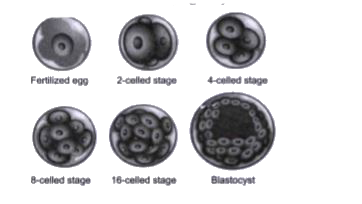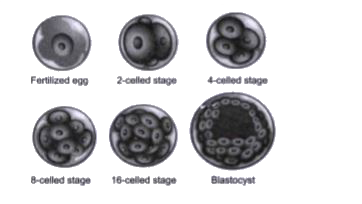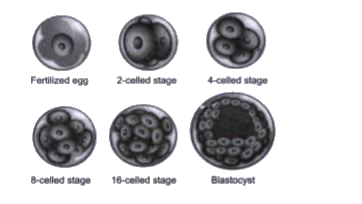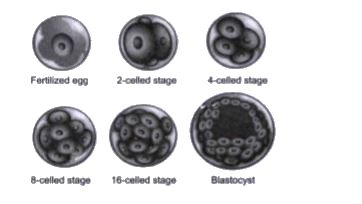The mitotic division starts as the zygi\oge moves through the of the oviduct called cleavage.
Ampulla
Isthmus
Fimbriae
Infiundibulum
The correct Answer is:B
Step-by-Step Solution:
1. Understanding the Zygote and Cleavage: The zygote is formed when a sperm fertilizes an egg. After fertilization, the zygote begins to divide through a process called cleavage, which involves mitotic divisions.
2. Location of Cleavage: The zygote travels through the oviduct (also known as the fallopian tube) after fertilization. The cleavage process starts as the zygote moves through a specific section of the oviduct.
3. Identifying the Oviduct Sections: The oviduct consists of several parts:
- Fimbriae: The finger-like projections that help guide the egg.
- Infundibulum: The funnel-shaped end of the oviduct.
- Ampulla: The widest part of the oviduct where fertilization typically occurs.
- Isthmus: The narrow section of the oviduct that connects to the uterus.
4. Cleavage Occurrence: The cleavage begins in the isthmus of the oviduct. This is where the zygote undergoes mitotic divisions as it moves towards the uterus.
5. Conclusion: Therefore, the correct answer to the question is that the mitotic division starts as the zygote moves through the isthmus of the oviduct.
Final Answer: The mitotic division starts as the zygote moves through the isthmus of the oviduct.
---
- Fimbriae: The finger-like projections that help guide the egg.
- Infundibulum: The funnel-shaped end of the oviduct.
- Ampulla: The widest part of the oviduct where fertilization typically occurs.
- Isthmus: The narrow section of the oviduct that connects to the uterus.
Topper's Solved these Questions
- REPRODUCTIVE SYSTEM , EMBRYOLOGY AND REPRODUCTIVE HEALTH BOOK - ALLENCHAPTER - REPRODUCTIVE SYSTEM , EMBRYOLOGY AND REPRODUCTIVE HEALTH EXERCISE - Exercise-IV (Assertion & Reason)
38 Videos
- REPRODUCTIVE SYSTEM , EMBRYOLOGY AND REPRODUCTIVE HEALTH BOOK - ALLENCHAPTER - REPRODUCTIVE SYSTEM , EMBRYOLOGY AND REPRODUCTIVE HEALTH EXERCISE - Exercise -I (Conceptual Questions)
25 Videos
- REPRODUCTIVE SYSTEM , EMBRYOLOGY AND REPRODUCTIVE HEALTH BOOK - ALLENCHAPTER - REPRODUCTIVE SYSTEM , EMBRYOLOGY AND REPRODUCTIVE HEALTH EXERCISE - AIIMS 2015
3 Videos
- REPRODUCTIVE HEALTHBOOK - ALLENCHAPTER - REPRODUCTIVE HEALTHEXERCISE - S
19 Videos
- RESPIRATION IN PLANTSBOOK - ALLENCHAPTER - RESPIRATION IN PLANTSEXERCISE - Diagram Based question
5 Videos
Similar Questions
Knowledge Check
Cleavage is the series of rapid mitotic divisions in zygote and forms blastula. The 2, 4, 8, 16 daughter cells are called blastomere. Embryo with 64 blastomere is known as blastocyst and has blastocoel cavity. Blastocyst gets implanted in uterine wall and leads to pregnancy.

Solid mass of cells with 16 blastomere is called:AMorulaBBlastulaCGastrulaDZygoteCleavage is the series of rapid mitotic divisions in zygote and forms blastula. The 2, 4, 8, 16 daughter cells are called blastomere. Embryo with 64 blastomere is known as blastocyst and has blastocoel cavity. Blastocyst gets implanted in uterine wall and leads to pregnancy.

The solid mass of 8-16 cells formed from zygote after successive mitotic division is called:ABlastulaBGastrulaCMorulaDNone of theseCleavage is the series of rapid mitotic divisions in zygote and forms blastula. The 2, 4, 8, 16 daughter cells are called blastomere. Embryo with 64 blastomere is known as blastocyst and has blastocoel cavity. Blastocyst gets implanted in uterine wall and leads to pregnancy.

Correct sequence of various structures formed during embryonic development:AMorula → Embryo → Gastrula → BlastulaBZygote → Embryo → Morula → BlastulaCBlastula → Morula → Gastrula → ZygoteDZygote → Morula → Blastula → Gastrula
A charge +Q is uniformly distributed over a thin ring with radius R. A negative point charge −Q and mass m starts from rest at a point far away from the centre of the ring and moves towards the centre. Find the velocity of this particle at the moment it passes through the centre of the ring .
View SolutionGiven below are four statement (A-D) each with one of two blanks .Select the option which correctly fill up the blanks in two statements
A The human male ejaculates about (i) million sperms during a cooitus . Out of which for normal fertility at teast (iii) percent sperms must have normal shape and size
B. A primary spermatocyte completes (i) meiotic division leading to the formation of two equal haploid cells called (i)
C. Spermatogenesis starts at the age of (i) due to significant increase in the secretion of (ii) a hypothalamic hormone
D. Oogenesisi is initiated during embryonic development and at puberty only (i) primary follicles are left in each overy
View SolutionCleavage is the series of rapid mitotic divisions in zygote and forms blastula. The 2, 4, 8, 16 daughter cells are called blastomere. Embryo with 64 blastomere is known as blastocyst and has blastocoel cavity. Blastocyst gets implanted in uterine wall and leads to pregnancy.

Site of implantation is:
View SolutionThe ability of your joints to move through a full range of motion is called:
View SolutionCleavage is the series of rapid mitotic divisions in zygote and forms blastula. The 2, 4, 8, 16 daughter cells are called blastomere. Embryo with 64 blastomere is known as blastocyst and has blastocoel cavity. Blastocyst gets implanted in uterine wall and leads to pregnancy.

The cells within the inner cell mass that possess the ability to give rise to the entire organism are called:
View Solution
